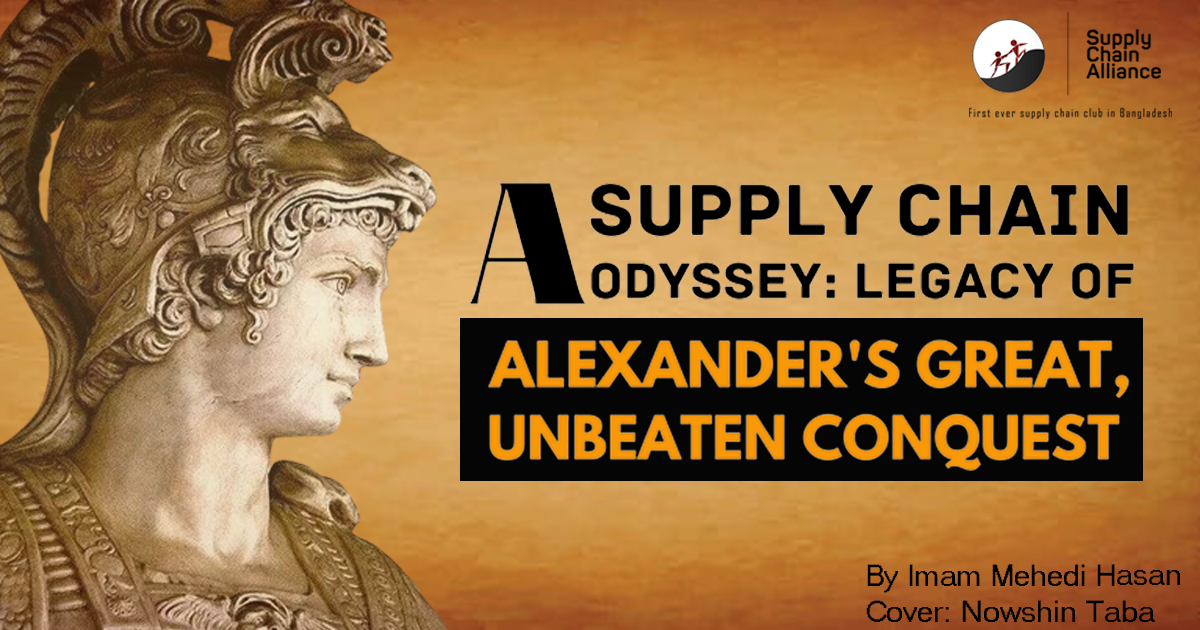If talking about one of the greatest conquers ever to have existed, Alexander the Great would doubtlessly be at the top of the list. However, besides being the greatest conqueror, he also happens to be the most exceptional supply chain manager of his time. Looking back at his conquest of the Greek city-states, parts of Africa, and Asia, many people give the majority of the credit to his brilliant leadership skills and the sarissa-wielding phalanx. However, a vital fact that is most often overlooked by many is his profound control of logistics and supplies. In his grand conquest, Alexander made use of a logistics system that radically transformed into the most efficient of its time.
The logistics system of an army has always been crucial to its success, and Alexander’s army was no exception. His great conquests would not have been possible without the skillful organization of his forces and supplies. While conquering Asia, he had to plan his provisions for 64000-75000 soldiers, 35000+ non-combatants, and hordes of animals (Mhugos, 2017). Even with current technologies, providing supplies to such an army from one continent to another is no simple task. Around 3000 years ago, whenever nations went into wars, their army would usually be accompanied by thousands of non-combatants- slaves and attendants. They would usually carry the essential supplies and even sometimes outnumbered the soldiers. They dramatically reduced an army’s speed, and each follower increased the number of mouths to feed. Furthermore, the armies used oxcarts and wagons which impeded an army’s speed and mobility further. This system was therefore designed only for short distances and slow movement.
Alexander aimed to create a system that prioritized his army’s sustainability, mobility, and speed. He understood the necessity of adapting to different scenarios and combined various strategies to supply his army. Alexander established a single point of control and made the decisions for his army. To increase speed, he used horses as the prominent pack animal and increased the number of supplies carried by his men. Each soldier carried his rations, utensils, blankets, road-building tools, medical supplies, a thirty-day supply of flour, and any personal possessions with them. Altogether this would have weighed around thirty-six kilograms. Alexander drastically reduced the number of non-combatants accompanying the army. Thus, his army became quicker and capable of inflicting lightning strikes on opposing forces. Also, he could sustain his army in the field significantly longer than his counterparts. In 335 BC, to crush a Theban revolt, his army marched from lake lychnis to Boeotia, covering 500 miles in thirteen days and catching the Theban rebels completely off-guard.
With a newly-reformed logistics system to support and supply his army, in 334 BC, Alexander set forth for Asia. Fighting in Asia was not the same as fighting in Europe. Alexander soon adapted the logistics system to suit his new theatres of war. Camels were introduced into Alexander’s army in either Syria or Egypt, and this desert animal played a critical role in his conquests. While the horse or a mule carries 200 pounds of supplies over a long distance, camels can transport 300 pounds. They were also well-suited for crossing arid terrains with barely any limitations on what they could eat and drink. All that made them the perfect baggage animals for Alexander’s conquest of the Persian islands and beyond, where the need for speed across harsh deserts was critical.
Another equally important task was distributing notably food and water to the troops. Grain products such as wheat, barley, and millet were the staples of a Macedonian soldier’s diet. These were easily portable and could be stored indefinitely. The soldiers would consume those in the form of bread, biscuits, and porridge. If possible, to supplement their diet, they would also eat dried meat, salted fish, and shellfish. Each Macedonian soldier carried enough food rations to last at least ten days.
Every time before marching, Alexander made sure to secure his supply line. He preferred travelling closer to rivers to supply his army with ships from Europe. However, this would not be possible all the time, as he had to campaign through the rough terrains of Asia from time to time. After being continuously victorious from time to time, Alexander’s power and prestige in the east became renowned, and soon many of the remaining Persian officials surrendered. Alexander realized he could use this to solve his supply chain problem. He sent envoys ahead of his main army to meet the officials and secure arrangements for the army’s supply through their territory. However, when the officials did not surrender to Alexander, he took a different approach. Alexander never risked putting his army in a situation where it could be crippled or destroyed by a lack of provisions. He acquired intelligence about the region. Afterwards, Alexander would launch a lightning campaign against the region with a small elite force, keeping the main army back fully stocked until Alexander secured enough supplies for them to follow. Alexander’s forward planning and charisma helped him solve his supply chain problems throughout his conquests.
Some strategies may age with time, but their importance hardly diminishes. Alexander’s campaign in both Asia and Africa required precise and advanced logistical planning unlike any yet-seen in antiquity. Alexander’s legacy shows that even 2500 years ago, having a supply chain system far superior to his counterparts enabled him to emerge victorious throughout his campaigns. Alexander managed to perform his illustrious feats because he included logistics and supply-chain management into his strategic plans, as any company should do, to maintain a competitive edge and outperform its competitors.







